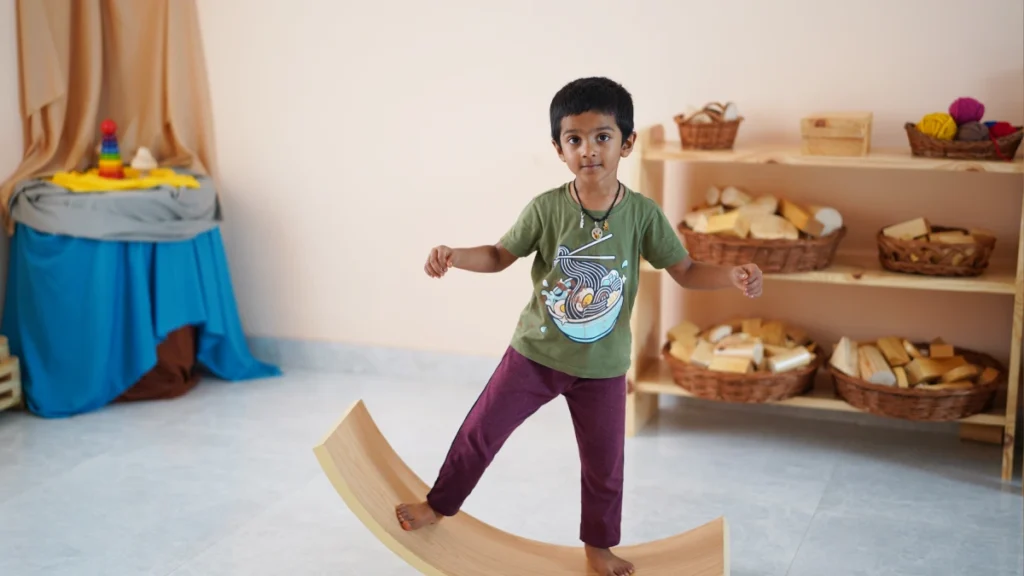In today’s world, screens are everywhere, but childhood doesn’t need to revolve around them. The less it is filled with screens, the more space children have to play, imagine, and grow into themselves.
Before we go further, let’s establish that screen-free does not mean anti-technology. It simply means making a conscious choice to reduce screen time and prioritise what matters most in the early years – real-world experiences, language, movement, sleep, and play. These are the building blocks of a healthy childhood, and they grow strongest when screens take a backseat.

Young children thrive on direct engagement – pouring water, kneading dough, listening to stories, digging in the mud, watching clouds, or chasing butterflies. These ordinary experiences awaken curiosity and wonder. But when everything is served instantly on a screen, that wonder fades. Instead of exploring and discovering, children receive ready-made answers. Instead of engaging their senses, they watch passively.
The bright colours, quick cuts, and loud sounds that keep adults hooked can actually overwhelm young children. Their senses become overstimulated rather than nourished. Over time, the instant rewards that screens provide can make it harder for children to practise patience, focus, and perseverance – qualities that grow naturally through play, conversation, and creative work.

As a Waldorf-inspired school, this is why the early years at Thraya are kept screen-free. Families are encouraged to keep home rhythms simple and to limit media during this stage. Later, in the middle and high school years, technology is introduced carefully and with purpose — as a tool for research, design, and presentation – but only after children have already developed strong attention, creativity, handwriting, and social skills.
Why Screen-Free Matters in the Early Years
Research shows that heavy screen use in the first five years can affect a child’s development. It is linked with weaker language skills, shorter attention spans, and lower problem-solving ability later in life. When screens creep into the evenings, sleep quality also drops, while background television at home often reduces both focus and conversation.
The effects often show up in everyday life. Children who spend more time on screens are more likely to become fussy, cranky, or restless. Constant stimulation makes it harder for them to calm down, manage emotions, or develop a steady sense of self.
By contrast, the difference is easy to see in children from screen-light homes. Parents who put phones and TVs aside during mealtimes or in the hour before bed often notice calmer evenings, deeper play, and easier bedtimes. Teachers also observe the same in classrooms: children tend to settle more easily, express themselves more clearly, work with their hands more confidently, and stay calmer throughout the day.

The Real Barriers in Homes — And Gentle Ways Around Them
In many homes, practical barriers make screen-free routines challenging. Late work calls, long commutes, grandparents who enjoy television, school assignments sent via apps, travel, weddings, and long waits often encourage reliance on screens. The solution is not strict rules or lectures, but small, practical swaps. Identifying a few high-pressure moments in the daily schedule, such as mealtimes, car rides, or waiting periods, allows for simple, screen-free alternatives: an audio story during a commute, a travel game during a queue, or a basket of books within easy reach in common spaces.
A Day That Works (Without Policing All Day)
Children thrive when days follow predictable rhythms. A few simple anchors can bring stability and a sense of security:
Regular routines – breakfast at a set time, outdoor play or a short walk each afternoon, and books before bedtime, help children move through the day with ease and look forward to what comes next.
Supportive environments – thoughtfully arranged toys and materials, chargers and devices kept out of sight, baskets with books within easy reach, and one inviting play corner that naturally draws attention more than a TV remote, encourage play and engagement.

Calm, consistent guidance – using gentle, steady phrases during transitions, such as “The TV rests now. Let’s light the lamp together.” or “Screens off now — it’s family dinner time.”, helps children understand expectations without repeated explanations or tension.
Shared family agreements – a short media plan posted for all adults and children, with simple rules like no screens at meals, in bedrooms, or in the last hour before sleep, reduce tension, prevent daily arguments, and create a smoother rhythm for the household.
Replace Screens With Things Children Actually Choose

Children do not need constant novelty; they need simple beginnings that invite them in. When materials and activities are kept visible and within reach, children gravitate towards them on their own. Screens no longer need to be resisted or replaced, they simply fade into the background.
Everyday activities like pouring, peeling, or sweeping give a sense of pride and focus. Open-ended play with blocks, a pretend kitchen, cars and ramps, or loose parts can fill long stretches of time with imagination.

Being outdoors while watering plants, catching a ball, cycling, or hopping through a game of hopscotch quickly restores balance and energy. Books and plain audio stories nurture language without overstimulation, while simple crafts like clay, cutting, threading, or sewing strengthen the hands for writing later on.
Simple Guardrails for Each Stage
0–2 years
At this age, personal screens are best avoided. Video calls can be kept for family connections, and children can be offered floor time, songs, kitchen chores as play, and lots of face-to-face talk.
2–5 years
If screens are introduced, keep them to one fixed slot of 30–60 minutes. Watch together, switch off autoplay, and follow the time with something active like outdoor play, movement, or hands-on work.
5–7 years
Schoolwork may require devices, but even here, structure helps. Keep screen use to a set time, group tasks together, print when possible, and balance the day with anchors like reading aloud, outdoor play, and creative handwork such as drawing or clay.
These gentle boundaries reflect what paediatric experts recommend and echo the rhythm Waldorf schools hold in the early years.

Signs It’s Working
The impact of screen-light rhythms often shows up in small, everyday ways. Three signals are especially telling: sleep, mood, and play/language.
When children fall asleep more easily and rest more deeply, it is a sign that evenings are calmer and less overstimulated.
When moods grow steadier, with fewer outbursts or restless moments, it shows that emotions are finding a natural balance.
When play becomes richer and language more expressive, it reflects growing focus and imagination.
These changes take time. A new rhythm needs a little time to take root, and it is common that the first days may bring resistance. But once routines settle, children usually begin to relax into them. Small improvements in even two of these areas are signs that the effort is working.








